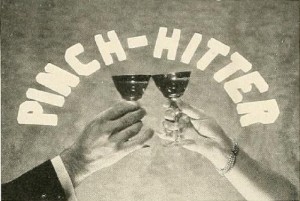
"Pinch Hitter, a photoplay by Charles J. Cafbonaro, has been given Honorable Mention because of its continuously sustained technical brilliance in the face of many problems of cinematic story telling. A suave situation comedy, it presents the dilemma of a girl who is asked once too often by her roommate to substitute for her on a temporarily undesired date. In time, the pinch hitter goes to bat for herself, knocks out a home run and leaves her roommate caught flat footedly out. In presenting this comedy of manners, Mr. Carbonaro has been helped by good acting from his players but hindered by not quite a light enough touch in the film's pace and direction. The lighting and camera work, which are genuinely of top flight quality, go far but not quite far enough in disguising this one weakness." Movie Makers, Dec. 1936, 550.
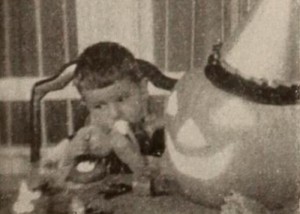
"To those filmers who have had the dubious honor of trying to direct a group of young, obstreperous children who somehow seem to persist in shyly gazing into the camera lens, Harlan M. Webber should be able to give some sound advice. Charming, but not cunning, Pinocchio's Jack-O'-Lantern seems to solve all the usual deficiencies which attend a film starring children. With a sure camera sense, Mr. Webber uses sparkling lighting and imaginative camera viewpoints to bring out the Peter Pan quality which pervades the Halloween party given by his son. The picture opens with startlingly clear shots of the small boy reading a Halloween book and continues with him helping his mother prepare the refreshments for the coming party. In a spirit of understanding and finesse, the filmer follows the antics of the disguised children through the party itself and on to the usual doorbell ringing, where they heinously blackmail the neighbors for candy, cookies and cake. Nostalgically provocative, the film exhibits a buoyant naturalness which would delight any audience." Movie Makers, Dec. 1946, 486.
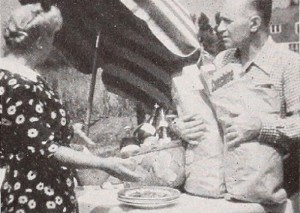
"George Mesaros, who has demonstrated his competence as a maker of good movies in other fields, turns to humor in this film comment on wartime conditions. The point of the story — for it is the foray and not the tale that is pointless — turns on providing for a picnic in the yard of the home. While the master of the house is shopping with ration points, the skeptical family gets, from the Victory garden, cooks and eats the alfresco feast, at the end of which Father — who really did find something in the shops — returns with loaded arms. First class Kodachrome pictures and a well knit continuity are used by Mr. Mesaros to bring to American audiences something of the spirit of easy and natural outdoor fun with food that for so long characterized the Europe of happy memory. Some of the scenes of cooking are so realistic that one almost reaches for what is shown on the screen." Movie Makers, Dec. 1943, 478.
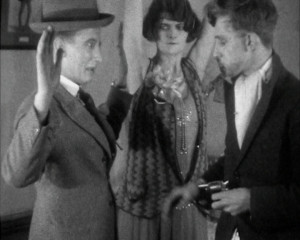
"A man entertains a married woman in her own home. He has previously stolen money from her husband’s wallet and hides the money in a book. The woman in turn removes the money from the book and keeps it for herself. The husband discovers their dalliance and orders the man to go. The man returns and accuses the couple of stealing his money. A burglar interrupts the proceedings. The burglar searches the pockets of the husband and removes (what looks like) another woman’s handkerchief. The burglar then searches the pockets of the man and the wife, discovering the money. The burglar offers the money to the husband in order to recompense him for embarrassing him in front of his wife and proceeds to steal other items from the room, leaving his revolver on the floor. The burglar says farewell. The husband and the man square up to each other" (EAFA Database).
"This film was specifically produced for a meeting of the London Amateur Cinematographers’ Association on 27 March 1929. The film was the basis of a competition for the club members. The club’s members in this case were invited to record the mistakes incorporated into the film. The report in Amateur Films notes that the competition was won by Mrs Nora Pfeil, who recorded approximately 30 mistakes" (EAFA Database).
"The Devon Amateur Film Production Society seems to be still forging ahead at a rapid rate. Its present production is a three reeler entitled “Pott’s Pride,” and it is anticipated that it will be cut and edited by the middle of April. All the “props,” scenery and reflectors have been made by members and though the developing and printing have been put out, the photographic section of the society has undertaken the tinting and toning of the print where necessary. It is hoped that every kinema in Devon will show the picture, the proceeds of which will be devoted to local charities. The film is being directed by Tom H. Hattershall and photographed by A. B. Sydenham, B.Sc." (Anon 1928, 62).
"Problems in the Pounding Surf is an animated cartoon of a little dog's antics in the ocean. Entered in a previous film competition, judges in that event stated "A truly fabulous animation film, extremely competent timing and use of line with good overall humor." So our judges were not alone in their praise of this workmanship. What our judges did not know and won't know until they read these words here is that the maker of this film, Dale Ramsey, is only 15 years old" PSA Journal, Aug. 1967, 37-38.
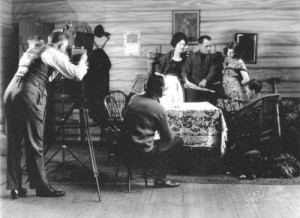
"A Race for Ties" tells the story of a sawmill owner, Joe Atwood, and his race against a large timber company, headed by U. Cheetem, to sign an exclusive contract for railway ties. In addition to a plot driven by one of the region’s staple industries (the lumber industry), the film highlights the scenic nature of the region" - Michel S Beaulieu, Women Film Pioneers Project.
"Reel Meal concerns the life of one meat ball, and is filmed to fit the tune of "On Top of Old Smokey." As a chorus sings specifically written words about one poor meat ball that got away, the scenes, cut to fit, record the antics of the fugitive from a plate of steaming spaghetti. A refreshing novelty well done" PSA Journal, Sept. 1964, 51.
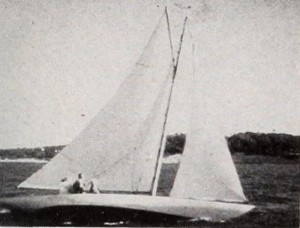
"In Reflections, Henry E. Hird has followed the intelligent practice of revising footage shot when film was more plentiful, with the result that he has created a new and interesting synthesis by editing. On a winter evening, a man reflects on the joys and adventures of a past summer. Of an athletic disposition, he has swum, sailed and hunted. Interested in wild life, he has observed and filmed birds. From time to time, he adjusts a radio, to find music that expresses the moods of his reverie. Finally, he turns off the radio, the musical accompaniment ceases and the film ends in silence. With excellent cinematography and with a nice editorial sense, Mr. Hird has gathered interesting events into an entertaining whole." Movie Makers, Dec. 1944, 496.
Total Pages: 23